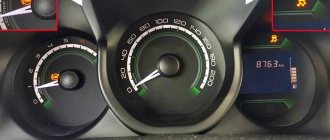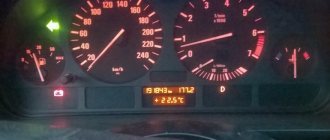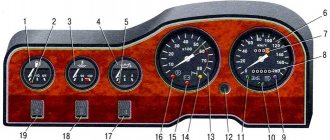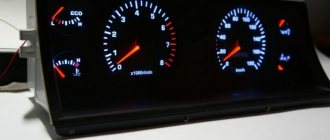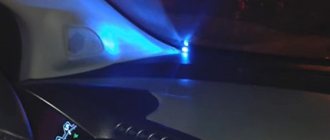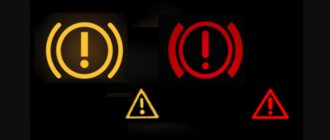Battery charging lamp is on - it means the generator is not working, the car owner’s first thought when he saw the battery icon on the dashboard. However, the reason why the charge indicator lights up is most often much more trivial - it is a loose drive belt tension or poor contact. But it is also possible that you will have to disassemble the generator because wear of the generator brushes or failure of the diode bridge, as well as some others, is possible.
The first thing to do if the battery charge light comes on while the engine is on is to check the voltage at the battery terminals. This is necessary in order to determine the location of the repair site - in the engine compartment or in the dashboard of the car.
| Situation when a malfunction occurs | The node that caused the malfunction | Possible causes of failure |
| When ignited, the battery light comes on | — | When the engine starts, that is, when the ignition is turned on, the battery warning light should light for 1...2 seconds and then go out. If it continues to glow, additional diagnostics are needed. |
| Battery light does not go out | Generator |
|
| Accumulator battery |
| |
| The battery charging lamp lights up periodically | Generator |
|
| The charging lamp is dim | Wiring |
|
| Generator |
| |
| Battery light flashes | Generator |
|
| At idle (low speed) the battery light comes on | Generator |
|
| Accumulator battery |
| |
| The battery light is on and goes out after recharging. | Generator |
|
| Signal lamp | The use of LED lamps instead of incandescent lamps in cars where the use of incandescent lamps is provided. | |
| The battery light comes on when driving | Generator |
|
| Battery | Partial or complete failure of the battery, its critical discharge. | |
| Battery light comes on when cold | Generator |
|
| The lamp is on, charging is in progress | Generator |
|
| Signal lamp |
| |
| Accumulator battery |
|
Reasons why the battery charge lamp is on
When the power supply is in good condition, the battery warning lamp on the dashboard lights up only when the engine starts, and after one or two seconds it goes out. If this does not happen, or, for example, the icon is activated when the engine is idling or while driving, this is a sign of a malfunction, and you need to look for the reason why the battery warning light is on. So, the causes of this malfunction may be problems with the following units.
Generator
Most often, the battery light comes on if the generator does not transfer energy to the battery after starting the engine. This happens when the following problems occur:
- Loosening the belt tension . Or a critical situation - its breakdown. In this case, the belt will slip along the pulley, due to which the generator pulley will not rotate at the required angular speed and, accordingly, generate electricity at a low voltage, insufficient for normal battery recharging. Another option for belt slippage is contamination of its inner surface and/or the surface of the generator pulley. In such situations, during the cold season, a whistle appears from under the hood.
- Brush wear . Over time, generator brushes wear out naturally, causing the generator to produce electricity at low voltage.
- Problems with the voltage regulator relay . The task of this unit is to limit the voltage transmitted from the generator to the battery. If the specified regulator fails, then usually the voltage is not transmitted to the battery at all, as a result of which the battery lamp on the panel lights up.
- Diode bridge . Its function is to convert the alternating current produced by the generator into direct current. Accordingly, if it fails, the generator will not charge the battery.
- Faulty generator pulley bearings . So, with significant wear (or with a very strong belt tension), significant bearing play or jamming may occur. This usually results in belt slippage with the consequences described above.
- Poor contact on the generator . Despite the fact that the terminal connection where the output wires of the generator are brought together is protected mechanically (usually by a cap or similar device), often over time the contacts can oxidize and become contaminated with dirt and/or oil. All this leads to poor contact and decreased conductivity. Similar reasoning is valid for “mass” contacts. If the ground is bad, the battery will not receive the proper charge, and accordingly, the battery icon will light up on the dashboard.
- Break in one of the phases of the generator winding (open circuit) . As a rule, this happens with contacts that are connected using a bolted connection. In particular, the bolt may unscrew over time and the contact between one of the phases and the diode rectifier may break. An open circuit is also possible if both power diodes on the rectifier unit fail. This can also happen with generators, where the contacts are connected not with bolts, but with soldering. Please note that in this case, the emergency lamp with battery on the dashboard will glow at half incandescence . And when you increase engine speed, it stops burning.
Battery
The battery icon on the panel lights up when the battery simply cannot accept a charge. The first reason for this is the old age of the battery or its partial failure. Alternatively, there is a low level of electrolyte in it. The second reason is oxidation of the terminals and contacts suitable for it or contamination of surfaces.
Signal lamp
On many domestic cars, for example, VAZ 2109, VAZ 2110, VAZ 2114, VAZ 2115, an old type lamp with a filament is installed as a battery warning lamp. On these models, it is possible to change this lamp when dismantling the instrument panel if it fails.
However, some car enthusiasts, due to inexperience or ignorance, install an LED lamp instead of an incandescent lamp. This leads to the fact that after starting the engine and idling, the lamp (at a voltage of just over 12 Volts) continues to burn. However, if you force the engine speed up to about 2000 rpm, the battery light goes out.
Wiring
Often the cause of incorrect operation of the battery lamp is damaged wiring. For example, when a lamp burns at half intensity or even dimmer, and in a variety of situations. Often the wiring is to blame. For example, a wire going from the battery to the generator. In particular, there are cases when, with a damaged wire (fracture, damage to the insulation), the lamp begins to glow a little even with a slight load on the battery.
Similarly, the battery lamp may burn at half incandescence due to poor contact on the voltage regulator (the so-called “chocolate bar”). Poor contact may be due to corrosion or mechanical damage.
Diagnostics and repair
First, check that the battery is not charging or the indicator light is not on and the battery resistance (ohmmeter) is not on.
Connect one multimeter probe to pin 30 of the generator, and the other to the generator housing.
If the diode bridge is working properly, the resistance value should tend to infinity.
- Then check the positive diodes for damage. The procedure is as follows:
- Connect one probe to pin 30 on the generator.
- The second multimeter probe should be placed on one of the diode bridge mounting screws.
- If everything is in order with the diodes, the resistance value tends to infinity.
Make sure the negative diodes are not "damaged":
- Place one multimeter probe on one of the diode bridge mounting screws.
- The second sensor should be placed on the generator housing.
- If the diodes are intact, the resistance tends to infinity.
- Checking additional LEDs:
- One probe is located at terminal 61 of the generator.
The second probe must be installed on one of the diode bridge mounting screws.
Generator brushes
When the diodes are ok, the resistance value tends to infinity.
Voltage regulator
A damaged pulley bearing can cause imbalance or seizure. In the first case, the belt will “eat up” and wear out. In the latter case, the generator shaft will not rotate or will jam. In any case, replace the bearing, if possible, or the pulley itself.
Diode bridge
As for the pulley bearing, the pulley is usually completely replaced with a new one.
- It is necessary to check the positive output contact of the car alternator. In particular, it should be free of traces of corrosion, oil, various process fluids, dust, and dirt. Therefore, clean all contacts. Same with “mass”. You need to check the quality of the contacts on it. It is also advisable to lubricate the closed contacts with a special protective lubricant.
- If one of the generator phases is broken or the power diodes are damaged after removing the generator, perform the following diagnostics:
- Check the threaded connections of the generator phase cables with the diode bridge. Most often, corrosion occurs on one of the contacts, a loosened (unscrewed) screw, or possible contamination. Therefore, for preventive purposes, it is necessary to inspect not only the damaged contact, but also other similar contacts. If the cable is broken, you can try to replace it, but it depends on the specific situation. Often in such cases (or if the insulation is damaged), the wires (winding) are replaced with new ones. Or the entire generator is replaced.
Identify damaged power diodes and replace them (replace diode bridge). Sometimes it happens that the soldering on the diodes is interrupted. In this case, the diodes are soldered.
- Check the stator winding for darkening of the windings. In this case, it makes sense to check the integrity of the insulation visually and with a multimeter by checking the insulation resistance value. If the insulation of the wires is darkened, it means that the generator is already significantly worn out and it is better to replace such a winding with a new one (rewind).
- If the wiring from the alternator to the battery is damaged, check and replace if necessary. At the same time, clean all contacts, both on the generator and on the battery (terminals). Clean the diode bridge contacts on the generator and its positive output contact.
- If oxidation appears on the generator brushes, they should also be cleaned. Make sure that the graphite from the brushes has not spread to other parts of the generator. If the brushes are worn out, replace them with new ones. Sometimes it is enough to improve the “chocolate” contact.
If the battery charge light is on but not charging, perform a complete check of the battery, alternator, fuses, lamp, and wiring. According to statistics, the most common cause of such a breakdown is wear of the generator brushes or problems with their contacts. The diode bridge fails less often.
Battery error
Many battery manufacturers use flashing lights to indicate that the battery's charge level is low.
In general, a laptop will quickly flash orange or red when its charge drops below a certain level while the computer is not plugged in.
If your laptop's battery light keeps flashing orange or red quickly, or if it stays red even when it's plugged into the charger, this indicates a problem with your battery or charger.
Checking fuses of VAZ 2106 - 2107 with a multimeter
You also need to know how to check a fuse in a car with a multimeter because in some cases replacing it does not eliminate the malfunction; the circuit needs a more thorough check. Usually its failure is visible to the naked eye, but in some cases the break can be detected only after an instrumental check. To do this, use a car tester or even a simple voltmeter to measure direct current.
- We attach the probes to the fuse.
- Next, using simple manipulations, we melt the wiring inside the fuse. Therefore, we made a non-working fuse out of a working fuse. What won’t you do for a good article!? :-). Again we apply the probes to the fuse and look at the behavior of the multimeter.
- The resistance is infinitely large, we do not hear any sound signal like “peep”. The fuse is broken. It can be thrown into the trash bin.
Is it possible to fix the problem?
It is important to keep in mind that if the battery is damaged, it is no longer possible to repair it. In the best case, it will have to be either completely changed or a partial replacement of elements. About laptop battery repair →
The charger can simply be disassembled into parts and tested using a multimeter. Most likely, the wiring has frayed or the contacts have come loose - this problem can be fixed with your own hands. However, if the capacitor burns out, you will have to look for a new, suitable charger.
Charging light flashing
The general signals sent by the light indicator, which is responsible for information about the state of the battery, look approximately the same. We will talk about the differences in color and its meanings between different laptops a little later.
Typically, the light bulb flashes the following colors, and each of them has the following designation:
Battery
A common cause is lack of charge. To clarify, check the voltage at the terminals using a load fork or measure it with a tester. Normal voltage is 14V, in case of problems it will be lower.
Options for solving the problem depending on the situation.
- The generator supplies voltage, but the battery discharges quickly. In this case, the wires and contacts are stripped, after which the readings are taken again. When the current level is not restored, the voltage on the device is measured. If it is higher than on the battery, then the cable is replaced.
- No voltage to the battery. The cause may be a blown fuse that needs to be replaced.
- The voltage is normal, but drops sharply under load. The reason is a generator malfunction.
Also check the battery terminals. Oxidized weak contacts are protected with fine sandpaper and then coated with a special agent.
Fuse relay is faulty
Another possible problem is a faulty relay. Some car modifications are equipped with a relay that monitors the battery charge light on the instrument panel. As soon as the relay fails, the indicator does not work either.
Fuse relay VAZ 2107
To test the relay, you should arm yourself with a multimeter. They measure the current at the positive output of the relay. If the voltage is less than 6V, then there is clearly a problem with the generating device. If the value is even higher, then the relay is faulty. It needs replacing.
Thus, finding out the reason why the battery light does not light is extremely important for adjusting the indicator and protecting the car from more serious malfunctions
Voltage regulator
Generators have two windings – rotor and stator. Moreover, the first one performs the functions of the excitation winding. We need to remember the theory: without a moving magnetic field, generating electricity is impossible. Therefore, it is enough to apply voltage to the rotor winding to obtain a magnetic field. Well, since the rotor is a moving part of an electric machine, it becomes clear that the magnetic field will rotate. And if the battery charging light periodically lights up, this indicates that there is a minor defect in the generator.
But why install a voltage regulator specifically in the power circuit of the excitation winding? After all, it is necessary to carry out stabilization in the stator circuit. This is true, but it’s worth remembering the theory: the output voltage depends on the magnitude of the magnetic field. Everything is very simple. It is enough to stabilize the power supply in the rotor winding circuit so that there are no oscillations at the output. It is much easier to stabilize small currents than large ones (can reach several tens of amperes).
Windows charging indicator
If you're not sure what the light means, you can check your computer's charging status in Windows.
Look for the battery icon in the notification area of the taskbar. If the display icon shows an electrical connector on the battery, then it is currently charging or is fully charged.
If there is no electrical plug and your computer is connected to the charger, then there may be a problem with the charger or battery.
A red "X" on the battery icon will appear on the screen when Windows detects battery problems.
Hover your mouse over the icon to view the current battery level. Then a tooltip will appear with information about the current charge level and charge status.
Reset
If your laptop battery is not charging, you can solve this problem by doing a hard reset. Turn off the computer, disconnect it from the charger and remove the battery. Follow your computer manufacturer's instructions to remove the battery.
On some computers, you may need to hold down the computer's power button for 30 seconds to reset the battery status information. Install the battery, connect the charger and turn on the laptop.
Charger
Most laptops show a green, blue or purple light to indicate that the battery is fully charged.
Many manufacturers indicate that a laptop is in the process of charging by showing a steady or flashing green, orange, blue or purple light.
If the battery light is green, blue or purple, then the battery is functional, regardless of whether the light is flashing color or not.
If the light is orange, the laptop is most likely charging.
The battery indicator on the laptop is blinking - the charger is not charging
Most laptops use a series of colored lights to indicate the state of the computer, which can tell you a lot.
Each indicator has several states, such as on, off, slow flashing or fast flashing.
They can also switch between different colors: green, blue, red, orange and purple (much depends on the model).
If you have problems with the charge indicator, the first thing I recommend is to calibrate the battery.
Each computer manufacturer uses its own codes to indicate the charging status of a laptop, but there are some common features.
Generator
At the first stage, the generator is checked. Possible causes of the malfunction include:
- Weak voltage connections. Often in the spring, after severe frosts, the compounds oxidize.
- Loose or broken drive belt. Modern cars control the parameter with a special sensor that sends information to the on-board computer.
- Malfunction of the diode bridge or pulley bearings.
- Worn slip rings or brushes.
A generator breakdown is known by its characteristic accompanying signs. Rapid battery discharge, extraneous noise while driving. A characteristic feature is a voltage drop during operation of consumer sources (dim light, slow operation of brushes, low volume of the radio). A common problem with old cars.
Mechanical problems
Therefore, regardless of whether your car has a carburetor or an injector, it is better not to joke with the generator, but if malfunctions are detected, respond quickly to them.
If the generator stops charging, there is nothing good about it. It is necessary to immediately begin searching for the cause of such a malfunction. Otherwise, all your electrical equipment will be without power, and the battery will soon run out completely.
If the generator works well, then the battery will not need additional charging with special devices for many months, sometimes even years. The battery will consistently retain at least 60% charge. Thus, the batteries are constantly replenishing their charge reserve through the operation of the generator.



